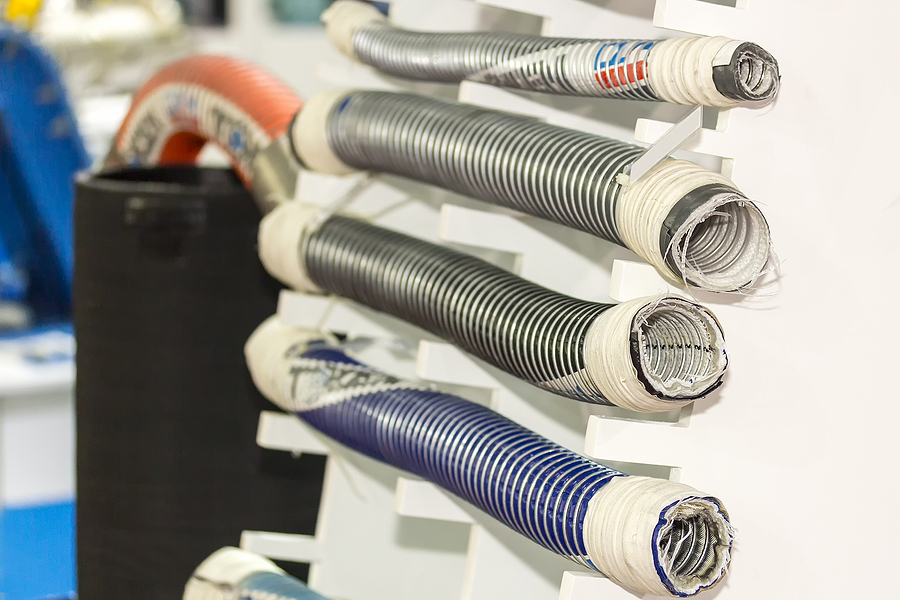In chemical transfer work, your team’s safety depends heavily on the hoses in use. A weak industrial hose can fail under pressure, leak toxic materials, or corrode when exposed to the wrong substance. Choosing materials for custom hoses ensures that hoses stand up to the demands of corrosive liquids, volatile compounds, and high temperatures. For OEMs and chemical processors, custom hose fabrication tailored to each application reduces risks, extends service life, and supports efficient operations.
The economic impact is just as serious. A rupture might trigger cleanup expenses, equipment damage, and possible regulatory fines. For that reason, companies must weigh more than performance; they must think about liability and compliance as well. Choosing materials for custom hoses in chemical transfer applications with proven resistance to specific chemicals is the first step toward minimizing exposure.
Material Options for Hose Durability
The right choice of hose material depends on your application. A plant handling strong acids under high heat may favor PTFE, while a facility moving milder chemicals at lower cost might rely on rubber.
Some material options for chemical transfer applications include:
- PTFE (Polytetrafluoroethylene): Handles strong acids, solvents, and high heat with excellent chemical resistance.
- Rubber: Provides flexibility and cost savings for less aggressive chemicals.
- PVC (Polyvinyl Chloride): Offers lightweight construction and affordability for light-duty transfer.
- Stainless Steel: Withstands extreme temperatures and pressure with strong durability.
- Composite Materials: Combines multiple layers for broad chemical compatibility and added safety.
- Silicone: Resists heat and maintains flexibility in certain pharmaceutical or food-grade transfers.
By matching hose material to the chemical properties, temperature range, and pressure involved, companies reduce the chance of failure and ensure that hoses last longer in service.
Safety Standards for Chemical Hoses
Hoses in chemical transfer must comply with industry regulations. Standards set by OSHA, ANSI, and other organizations establish minimum safety requirements for construction and performance. Following these guidelines is more than a legal step; it protects workers and prevents environmental harm.
Matching Hose Type to Chemicals
Chemical compatibility is critical. Certain solvents may eat away at rubber, while hydrocarbons may perform safely in that same hose type. PTFE, with its broad chemical resistance, often becomes the go-to for aggressive materials, but it may not always be the most cost-effective choice.
In addition to compatibility, operating conditions matter. Pressure ratings, temperature extremes, and flow requirements all influence which hose is best. Reviewing safety data sheets and manufacturer specifications ensures the hose will hold up in the exact conditions it faces. Making the right match prevents leaks, protects equipment, and secures continuous operation.
Testing for Long-Term Reliability
Testing verifies that hoses can withstand years of use in harsh conditions. Pressure tests, temperature cycling, and chemical exposure trials measure whether a hose will hold up under stress. These evaluations prevent surprises in the field, where a single failure could disrupt production.
Reliability testing should not stop at installation. Periodic monitoring for flexibility, wall integrity, and resistance performance allows companies to catch problems before they lead to shutdowns. A structured testing program, combined with solid maintenance, extends hose life and improves workplace safety.
Contact Our Team for Hose Solutions
Our team helps companies select hoses that meet the demands of chemical transfer applications. We work with rubber, PTFE, and composite assemblies, tailoring each solution to the chemicals, pressures, and temperatures involved. Contact Hose Heaven at (973) 404-1500 or use our contact form to get help finding the right hoses for your needs today. Every hose we provide is built for performance and tested for reliability.

